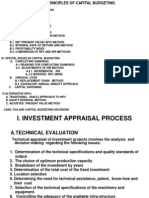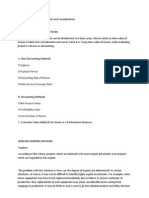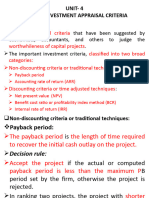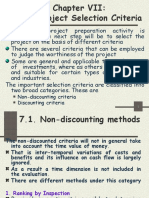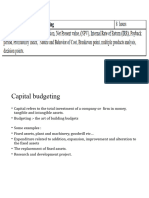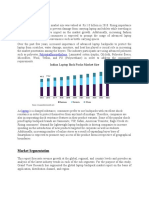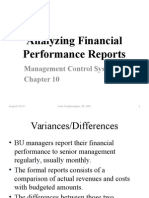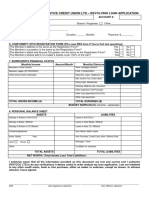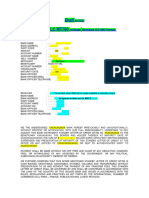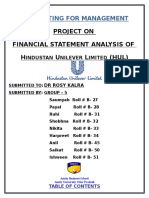CHAPTER FIVE
PROJECT SELECTION
5.1. PROJECT FINANCIAL APPRAISAL’S DECISION CRITERIA METHODS
Usually the decision criteria are divided into two groups: non-discounting and discounting
measures. The first group does not take into account time preference while the second group is
more appropriate decision criteria because they include time preference, discounted value, into
the computations.
5.2.1. NON-DISCOUNTING MEASURES
The non-discounting criteria to appraise projects do not consider the time value of money. The
dominance and normalizing, payback period, average rate of returns (average return and
average yearly net return) and urgency are the appraisal methods included in non-discounting
criteria.
a. Dominance and Normalizing
Dominance can be strong dominance or weaker dominance. If a project is expected to cost less
and to have higher producer's surplus for each year of its life and to last stronger than the
alternative, we call it strong dominant project. On the other hand, when, for example, projects are
identical except for a single expected value, the project with a smaller initial cost or a single
larger producer's surplus will be the preferred one, other things being equal. It is the single
difference that determines the decision. This type of project is called weaker dominant project.
Table 5.1: Strong Dominance
Producer's Surplus
Project Initial cost Year 1 Year 2 Year 3 Year 4
1 $20,000 $10,000 $10,000 $10,000 $5,000
2 $30,000 $ 8,000 $ 9,000 $ 9,000 0
Since project 1 is preferable to project 2 in all respects, we say that project 1 dominates project 2.
Page 1 of 13
� Table 5.2: Weaker Dominance
Producer's Surplus
Project Initial cost Year 1 Year 2 Year 3 Year 4
1 $20,000 $10,000 $10,000 $10,000 $5,000
2 $20,000 $10,000 $10,000 $10,000 $4,000
Project 1 dominates project 2 for the producer's surplus during year 4.
It is unlikely that actual projects will be as directly comparable as the above examples suggest.
Real proposals almost vary in both their initial costs and producer's surplus. The relative merits
of dissimilar proposals become evident only once they have been made comparable by
normalizing the benefits and costs that is converting the projects to the base of an assumed
common initial expenditure.
Table 5.3: Normalizing Projects
Producer's Surplus
Project Initial cost Year 1 Year 2 Year 3 Year 4
1 $20,000 $10,000 $10,000 $10,000 $ 5,000
2 $80,000 $30,000 $30,000 $30,000 $15,000
Normalize 2 $20,000 $ 7,500 $ 7,500 $ 7,500 $ 3,750
Normalizing project 2 with respect to project 1, dividing its initial cost and surpluses by 4, the
two projects prevail a common initial expenditure of $20,000 and that the producer's surplus are
comparable. When we compare the first row and the third row of the table, we see that project 1
clearly dominates project 2. For each dollar spent, project 1 has the higher streams of expected
net surplus.
b. Payback and Cut-off Periods
This technique concern with the number of years it takes to earn revenues sufficient to cover the
costs. It involves asking this question. How long does it take to get back (or recuperate) my
money?
The standard approach involving the use of the concept of a payback period (or the recoup
method) ranks the proposals by the amount of time it would take to recover the initial
investment. Then, the project with the shortest payback period is selected first, followed by the
Page 2 of 13
�one with the next shortest, and so on until the available investment funds are exhausted or some
other limit is reached.
Cut-off period, on the other hand, is the maximum period of time determined by the analyst to
recover project's initial investment. A single proposal will be pursued if its capital cost (initial
investment) can be recovered within the cut off period; if not, the project will be rejected.
These two techniques may be suited for the analysis of projects where the goal of a quick
investment recovery is itself reasonable. However, these techniques ignore the pattern in which
payments are expected to occur including those beyond the payback and cut off point and do not
consider time preference and discounting.
Table 5.4: Project Choices
Producer's Surplus
Projec Initial Cost Year 1 Year 2 Year 3 Year 4 Year 5 Year 6 Year 7
t
1 $50,000 $10,000 $40,000 $10,000 $10,000 $10,000 $10,000 $10,000
2 $50,000 $40,000 $ 7,000 $ 2,000 $ 1,000 $10,000 $10,000 $10,000
3 $50,000 $10,000 $10,000 $10,000 $10,000 $10,000 $ 5,000 $ 5,000
4 $50,000 $30,000 $10,000 $10,000 $10,000 $ 5,000 $ 4,000 $ 1,000
Table 5.5: Payback and Cut-off Periods
Project Payback period (Years) Ranking Three year cut-off
st
1 2 1 Accept
2 4 3rd Reject
th
3 5 4 Reject
4 3 2nd Accept
c. Average Rate of Return (Average Return and Average Yearly Net Return Methods)
The criterion of the average return involves dividing the sum of expected producer's surplus by
the initial cost figure. Proposals under review are ranked from the highest average return ratio to
the lowest.
Average Return = Σ Producer's Surplus
Page 3 of 13
� Initial Cost
Table 6.6: Average Return
Project Sum of producer's Surplus Initial Cost Average Return Ranking
1 $100,000 $50,000 200% 1st
2 80,000 $50,000 160% 2nd
3 60,000 $50,000 120% 4th
4 70,000 $50,000 140% 3rd
The average return criterion recognizes all of the returns over the life of the investment.
However, it does not produce reliable rankings. If the projects are not of similar duration and it
doesn't consider time preference and discounting.
Average Yearly Net Return (AYNR), which is a variation of the average return, allows the
comparison of projects of different life times through computation of the average percentage
return on the initial investment per year. Under this technique, for a single project to be accepted,
the average yearly net return must be at least the rate of interest available in the company and at
least the current interest rate.
Average Yearly Net Return = Σ Producer's Surplus - Initial Cost
(Initial Cost) (Number of Years)
Table 4.7: Average Yearly Net Return
Sum of producer's Number of Average yearly
Surplus minus Initial Years Net Return
Project Cost Initial Cost Ranking
1 $30,000 6 $50,000 10% 1st
2 $30,000 10 $50,000 6% 2nd
3 $10,000 5 $50,000 4% 4th
4 $20,000 8 $50,000 5% 3rd
The average yearly net returns technique attempts to recognize the importance of forgone
opportunities by incorporating interest; its chief requirement is that the project earn the interest
foregone, on the average. However, it doesn't incorporate time preference and discounting.
Page 4 of 13
�Note that although the preliminary project appraisal criteria discussed can certainly be useful in
some cases, none of them take into account risk and uncertainty, time preference, and
discounting.
d. Urgency
According to the urgency method, projects that are more urgent get priority over those that are
less urgent. It is subjective criterion that can be defined in certain situations like failure of an
important machine that affects the entire operation. Therefore, when there are two or more
projects that require funds, only those that are more urgent will be funded.
Activity 6.2: Appraise and give your expert opinion on the following two projects using (1) dominance,
(2) average return, and (c) pay back period (assuming the cut-off pay back period is 3 years.
Project A Project B
Initial Investment (t0) $50,000 $75,000
Cash Inflows Year 1 15,000 40,000
2 5,000 12,000
3 40,000 8,000
4 10,000 10,000
5 10,000 10,000
5.2.2. DISCOUNTING MEASURES
The discounting criteria to appraise projects consider the time value of money. The three
discounting value project criteria in frequent use to decide whether a single project proposal is
acceptable or not are: Benefit-Cost Ratio (BCR), Net Present Value (NPV), and Internal Rate of
Return (IRR). These three-decision criterions yield the same decision for a single project where
resource statements are drawn up using the same information and assumption.
a. Benefit-Cost Ratio (BCR)
For a project to be acceptable, the discounted value of its benefits should exceed the discounted
value of its costs. Discounted benefits can be expressed in a ratio to discounted costs.
BCR= Σ Discounted Benefits
Σ Discounted Costs
Page 5 of 13
�Then, the BCR can be used for decision making as follows:
If BCR>1.0, accept the project proposal,
If BCR<1.0, reject the project proposal, and
If BCR=1.0 there will be no net effect whether the project proposal is accepted or not.
The BCR for a project will depend not just upon the estimated future project effects but also up
on the rate at which they are discounted. The decision whether to accept the proposal or not,
therefore, depends on the value of the discount rate (the opportunity cost of resources) at which
decisions are made.
Figure 6.1: Benefit-Cost Ration (BCR)
A The BCR lines slope down wards to the right
Benefit as the rate of discount is increased; the key
Cost feature being where the BCR line crosses the
Ratio B horizontal line defining the value BCR = 1.0
A
B
Rate of Discount
b. Net Present Value (NPV)
NPV is the result for which discounted costs are subtracted from discounted benefits.
NPV = Σ Discounted Benefits - Σ Discounted Costs
The decision criterion using the NPV can be expressed formally as follows:
If NPV>0, accept the project proposal,
If NPV<0, reject the project proposal, and
If NPV=0, the project will have no net effect whether it is accepted or not.
Like the BCR, the NPV will vary with the rate of discount. The NPV for a project resource
statement also slopes down to the right as the discount rate is increased.
Page 6 of 13
�Figure 4.2: Net Present Value (NPV)
A
NPV
Rate of Discount
B
A
The key features of the NPV curves are the value they take at the discount rate. Another key
feature of the NPV curves is the points at which they cross the horizontal axis. The NPV curves
cross the horizontal axis at the rate at which the discounted value of benefits is equal to the
discounted value of costs.
c. Internal Rate of Return (IRR)
The rate of discount at which the NPV curve crosses the horizontal axis for a particular project
resources statement [Discounted Benefit = Discounted Cost], where NPV = 0, is the IRR.
Besides IRR may exist where the BCR line crosses the horizontal line at BCR = 1.0. IRR
represents a rate of return on all the resources committed in a project.
For a project to be accepted, it should generate an IRR at least as great as the opportunity cost of
resources. The decision-making criterion using the IRR is:
If IRR>d, accept the project proposal,
If IRR<d, reject the project proposal, and
If IRR=d, the project will have no net effect whether it is accepted or not.
Where, d = opportunity cost of resources.
ILLUSTRATION ON DISCOUNTING-MODELS OF THE FINANCIAL APPRAISAL
TECHNIQUES
Page 7 of 13
�A firm can make either of the two investments, Project A or Project B, at time 0. assuming a RRR
(k*) of 14% and a cut-off point for PBP of 4 years, 1) determine for each project (a) PBP, (b) NPV,
(c) BCR, and (d) IRR; and 2) forward your professional opine on accepting or rejecting the projects.
Project A (PA) Project B (PB)
Initial Investment (t0) $28,000 $28,000
Cash In Flows Year 1 8,000 5,000
2 8,000 5,000
3 8,000 6,000
4 8,000 6,000
5 8,000 7,000
6 8,000 7,000
7 8,000 7,000
Solutions:
1a) Pay Back Period (PBP)
Project A = 3 Years + ($4,000/$8,000 * 12 Months) => 3 Years and 6 Months.
Project B = 3 Years + ($4,000/$6,000 * 12 Months) => 3 Years and 8 Months.
Opinion:
Both projects account PBP less than the cut-off PBP, i.e., 4 Years. However, the firm is
interesting to invest on only either of the two projects. The two projects are mutually exclusive.
Therefore, accept Project A because its PBP is shorter than that of Project B.
Year Project A (I0) = $28,000 Project B (I0) = $20,000
Cash In Flows (CIFs) Cumulative CIFs Cash In Flows (CIFs) Cumulative CIFs
1 8,000 8,000 5,000 5,000
2 8,000 16,000 5,000 10,000
3 8,000 24,000 6,000 16,000
4 8,000 32,000 6,000 22,000
5 8,000 40,000 7,000 29,000
6 8,000 48,000 7,000 36,000
7 8,000 56,000 7,000 43,000
1b) Net Present Value (NPV)
For Project A, use the annuity present value table for discounting its future cash inflows, because
it has annuity (regular) future cash inflows.
PV of CIFs = Annuity CIF * PVIFA (14%, 7 Years) => $8,000 * 4.2883 => $34,306.40.
Page 8 of 13
� NPV of PA = $34,306.40 - $28,000 => $6,306.40. This NPV is when Io = $28,000.
What is the NPV when the Io = $20,000 (i.e., Normalize Project A to Project B)?
$20,000/$28,000 * $6,306.40 = $ 4,504.57.
For Project B, use the $1 present value table for discounting its future cash inflows, because it
has irregular future cash inflows.
Year CIFs ($) (1) Present Value Interest Factor (PVIF, 14%,7Years) (2) Present Value (PV)
(3) = (1) * (2)
1 5,000 0.8772 $4,386.00
2 5,000 0.7695 3.847.50
3 6,000 0.6750 4,050.00
4 6,000 0.5921 3,552.60
5 7,000 0.5194 3,635.80
6 7,000 0.4556 3,189.20
7 7,000 0.3996 2,797.20
Total Present Value (PV) $25,458.30
Less: Initial Investment (Io) $20,000.00
Net Present Value (NPV) $ 5,458.30
Opinion:
Accept Project B because its relative NPV is positive and greater than that of the normalized
NPV of Project A (i.e., $4, 504.57). Note that NPV requires normalizing when the Projects Io is
different because NPV results in cumulative effects over the project’s life; usually the higher
investment yields the higher benefit. But, the BCR and IRR do not require normalization because
BCR and IRR measure the return on $1 investment.
1c) Benefit - Cost Ratio (BCR)
BCR (PA) = PV of CIFs/Io => $34,306.40/$28,000.00 => ≈1.23
BCR (PB) = PV of CIFs/Io => $25,458.30/$20,000.00 => ≈1.27
Opinion:
Accept Project B because its return for $1 investment (i.e., $1.27) is greater than that of the
Project A (i.e., $1.23).
Page 9 of 13
�1d) Internal Rate of Return (IRR)
The determination of project’s IRR is a trial and iterative process. It is time consuming, thus the
following short-cut method is recommended.
Step 1: Compute Average Annual Cash in Flow (AACIF)
AACIF = CIFs/N, where N is project life.
Step 2:Compute Present Value Interest Factor of Annuity (PVIFA)
PVIFA = Io/AACIF
Step 3: Identify the range of ‘r’ in which the PVIFA (k,n), i.e., Step 2, falls given
the project life with the help of the annuity present value table.
Lr ------------------ PVIFA(k,n) ----------- Hr, where k is cost of capital.
Step 4: Compute, independently, the PV of CIFs for each candidate project at the
lower rate (Lr) and the higher rate (Hr) by using:
a) PVIFA table if the project’s CIFs is annuity
b) PVIF of $1table if the project’s CIFs is irregular.
Step 5: Compute IRR, independently, by using either of the following formulas
IRR at Lr = Lr + dr [(PV at Lr – I0)/(NPV at Lr - NPV at Hr )]
Or
IRR at Hr = Hr - dr [(PV at Hr – I0)/(NPV at Lr – NPV at Hr )]
Where, dr is change in Hr and Lr.
Check that the resulted IRR is in between the L r and Hr. If it is outside this range; there might be
mistake in your arithmetic calculations. IRR is where NPV is 0. NPV at L r is positive and NPV
at Hr is negative. Therefore, the NPV = 0 must be between Lr and Hr.
Page 10 of 13
�Project A
Step 1: Average annual CIF = $8,000, because it is annuity.
Step 2: PVIFA = $28,000/$8,000 => 3.5000
Step 3: Lr -------------------- PVIFA -------------- Hr
At 20% (3.6046) ----------- 3.5000 ----------- At 24% (3.2423)
Step 4: i) PV at Lr (20%, 7Years) by using the annuity present value table:
$8,000 * 3.6046 = $28, 836.80
ii) PV at Hr (24%, 7Years) by using the annuity present value table:
$8,000 * 3.2423 = $25,938.40
Step 5: i) IRR at Lr = Lr + dr [(PV at Lr – I0) / (NPV at Lr – NPV at Hr )]
IRR = 20% + (24%-20%)[($28,836.80 - $28,000)/[$836.8 – ($2,061.60)]
20% + 4%[$836.80/$2,898.40]
20% + 1.15%
≈21.15%
ii) IRR at Hr = Hr - dr [(PV at Hr – I0) / (NPV at Lr – NPV at Hr )]
IRR = 24% - (24%-20%)[($25,938.40 - $28,000)/[$836.80 – ($2,061.60)]
24% - 4%[$2,061.60/$2,898.40]
24% -2.85%
≈21.15%
The IRR for Project A where it’s NPV = 0 is ≈21.15% in both the Hr as well as L r. The 21.15%
is with in the range of the higher and lower rate, i.e., 20% to 24%. Thus, the arithmetic
computation is correct.
Project B
Step 1: Average annual CIF = $43,000/7Years => $6,142.86.
Page 11 of 13
�Step 2: PVIFA = $20,000/$6,142.86 => 3.2558
Step 3: Lr ----------------- PVIFA ------------- Hr
At 20% (3.6046) ----------- 3.2558 ------------- At 24% (3.2423)
Step 4: i) PV at Lr (20%, 7Years) by using the $1 present value table:
ii) PV at Hr (24%, 7Years) by using the $1 present value table:
PV at Lr (20%,7Years) PV at Hr (24%,7Years)
Year CIFs PVIF PV Year CIFs PVIF PV
1 $5,000 0.8333 $4,166.50 1 $5,000 0.8065 $4,032.50
2 $5,000 0.6944 $3,472.00 2 $5,000 0.6504 $3,252.00
3 $6,000 0.5787 $3,472.20 3 $6,000 0.5245 $3,147.00
4 $6,000 0.4823 $2,893.80 4 $6,000 0.4230 $2,538.00
5 $7,000 0.4019 $2,813.30 5 $7,000 0.3411 $2,387.70
6 $7,000 0.3349 $2,344.30 6 $7,000 0.2751 $1,925.70
7 $7,000 0.2791 $1,953.70 7 $7,000 0.2218 $1,552.60
PV $21,115.80 PV $18,835.50
I0 $20,000.00 I0 $20,000.00
NPV $1,115.80 NPV ($1,164.50)
Step 5: i) IRR at Lr = Lr + dr [(PV at Lr – I0) / (NPV at Lr – NPV at Hr )]
IRR = 20% + (24%-20%)[($21,115.80 - $20,000)/[$1,115.80 – ($1,164.50)]
20% + 4%[$1,115.80/$2,280.30]
20% + 1.9573%
≈21.96%
ii) IRR at Hr = Hr - dr [(PV at Hr – I0) / (NPV at Lr – NPV at Hr )]
IRR = 24% - (24%-20%)[($18,835.50 - $20,000)/[$1,115.80 – ($1,164.50)]
24% - 4%[$1,164.50/$2,280.30]
24% -2.0427%
≈21.96%
The IRR for Project B where it’s NPV = 0 is ≈21.96% in both the Hr as well as L r. The 21.96% is
with in the range of the higher and lower rate, i.e., 20% to 24%. Thus, the arithmetic
computation is correct.
Page 12 of 13
�Opinion:
Accept Project B because its IRR is greater than that of the Project A, i.e., 21.96% > 21.15%.
Note that the three discount models (i.e., NPV, BCR, and IRR) are alternatives. There is no need to
apply three of them while appraising the financial feasibility of a project. One of them is sufficient. If
the project is acceptable on NPV model; it is also acceptable on the BCR as well as the IRR. Thus, it
is advisable to employ the PBP from the non-discount models and any one of the three discount
models to appraise feasibility of any commercial project.
Activity 6.3: Appraise and give your expert opinion on the following two projects using (1) BCR, (2)
NPV (c) IRR. [Assume that the cost of capital (k*) is 10%]
Project A Project B
Initial Investment (t0) $50,000 $50,000
Cash Inflows Year 1 15,000 40,000
2 5,000 2,000
3 40,000 8,000
4 10,000 10,000
5 10,000 10,000
Page 13 of 13
